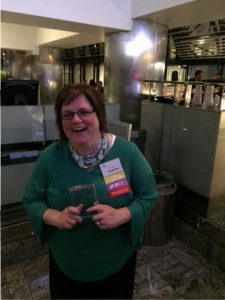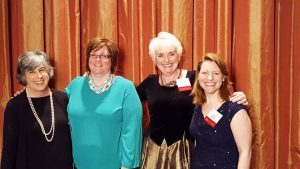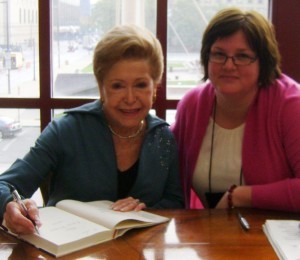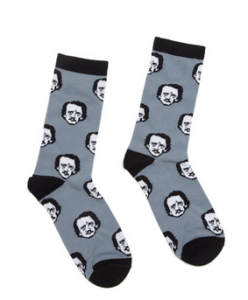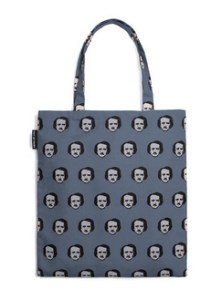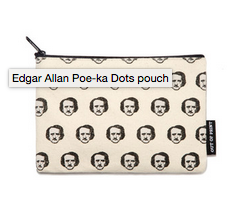Lori Rader-Day's Blog, page 7
May 6, 2016
Little Pretty Things WINS the Mary Higgins Clark Award!
OH, boy, do I need to get better at updating here. You win one huge mystery writing award, and things on your website go sadly out of date.
That’s right. WIN.
The Invisible Trophy, as I have nicknamed it, is that square of glass I’m holding (I swear it’s there). It’s lovely and I couldn’t be more excited to have it in my house, especially given how wonderful the other nominee books were. The ladies who wrote them? Also lovely.
From left: Hallie Ephron, me, Catriona McPherson, Susie Calkins. Not pictured: Frances Brody, she of Living in Far Away Places. Read their books!
Here’s my acceptance speech if you are so inclined (I can’t watch it. I lived it, Dottie.)
If you want the gist, I thanked the other four nominees, Mystery Writers of America, Mystery Writers of America Midwest, my agent Sharon Bowers, my editor Dan Mayer and everyone at Seventh Street Books, Mary Higgins Clark, who has been such a part of my reading and writing life, and of course my wonderful husband, who was there to see me win.
And then my agent, Greg, and I drank illicit wine in the hotel lobby, cackling like school kids. A good night.
I probably forgot to thank you, so accept my gratitude here and now.
The post Little Pretty Things WINS the Mary Higgins Clark Award! appeared first on Lori Rader-Day.
April 6, 2016
What would Mary write? The MHC Award nominees share notes
When I first met Mary Higgins Clark—on the shelf of my public library—I was 12. Pretty sure I was too young and naive for most of what I found between those covers, but I LOVED those books.
So to be nominated for the Simon & Schuster Mary Higgins Clark Award is no small thing for me. She is surely among the writers who made me the writer I am today.
Do I write like her? Not sure…but today on the Jungle Reds blog, hosted by Jungle Reds author Hallie Ephron, the five nominees for the 2016 Mary Higgins Clark Award compared notes on what makes a book “like” hers and where we fit on the criteria. It’s a fun post, and I’m so thrilled to be among such great writers.
The post What would Mary write? The MHC Award nominees share notes appeared first on Lori Rader-Day.
March 19, 2016
The most-read piece I’ve ever written
I once published a short story in Good Housekeeping, which goes to 26 million people worldwide. But I feel as though maybe an article that I wrote for Writers Digest online might be the most popular thing I’ve ever written, because WD trots it out about every three weeks, with lots of retweets and shares and likes. So here you go: I could write a check and it wouldn’t be as popular as this thing.
11 Steps to Finding the Agent Who’ll Love Your Book https://t.co/R9E4NP8Yw5 via @LoriRaderDay pic.twitter.com/Y7Yq4x1mTZ
— Writer’s Digest (@WritersDigest) March 19, 2016
The post The most-read piece I’ve ever written appeared first on Lori Rader-Day.
March 16, 2016
Win a copy of LITTLE PRETTY THINGS!
To celebrate SPRING FINALLY PLEASE and the Mary Higgins Clark nomination for Little Pretty Things, I’m holding my very own Goodreads giveaway! It might also be because March is my birthday month and I like presents, even when they’re presents I’m giving away. Enter at Goodreads!
Goodreads Book Giveaway

Little Pretty Things
by Lori Rader-Day
Giveaway ends March 31, 2016.
See the giveaway details
at Goodreads.
The post Win a copy of LITTLE PRETTY THINGS! appeared first on Lori Rader-Day.
March 7, 2016
A little something I’m working on…Murder & Mayhem!
Big news: Along with Dana Kaye from Kaye Publicity, I’m hosting the first-ever Murder and Mayhem in Chicago next March!
This event is based on a great event that has been going strong for 12 years in Wisconsin, now called Murder and Mayhem in Milwaukee, and by all means GO TO THERE. They’ll be hosting a long list of great authors this November, and then in March, hellooooo, another long list of great authors in Chicago. The winner in all this? Readers.
Learn who’s coming here and if you want to keep updated, sign up for the mailing list!
The post A little something I’m working on…Murder & Mayhem! appeared first on Lori Rader-Day.
Three questions with…Alex Segura
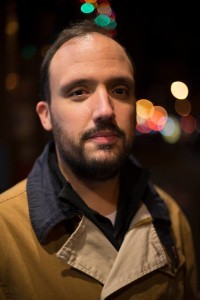 Have you ever known someone casually and then suddenly, by accident, had the chance to get to be better friends with him? That happened to me with Alex Segura the evening of the 2013 Anthony Awards in Long Beach, California. I hadn’t made plans to meet anyone there, the place was huge, and then there in the sea of humanity was a friendly face. Alex and I had a blast and got to know each other while watching some our friends take home beach-ball-themed trophies.
Have you ever known someone casually and then suddenly, by accident, had the chance to get to be better friends with him? That happened to me with Alex Segura the evening of the 2013 Anthony Awards in Long Beach, California. I hadn’t made plans to meet anyone there, the place was huge, and then there in the sea of humanity was a friendly face. Alex and I had a blast and got to know each other while watching some our friends take home beach-ball-themed trophies.I’m happy to see Alex’s face anytime we’re at the same mystery gathering, and now I’m happy to see Alex’s name on some new books, a reissue of his first novel, Silent City, and the just-released Down the Darkest Street. I’m also a big fan of Alex’s newest hobby—posting photos of his adorable new son on Facebook. It’s been a big year for Alex Segura!
Welcome, Alex!
What inspired the story of Down the Darkest Street?
Two things: I knew I wanted the sequel to Silent City—and the second novel featuring Pete Fernandez, a washed-up former journalist stumbling toward becoming a PI—to be darker. Which isn’t to say Silent City was light reading, but I wanted to really show Pete what a dangerous path he was on, having (kind of) chosen the life of a private detective. Florida is fertile ground for murderers and serial killers, so that got me to researching that, but I wanted to put a new twist on it. If it didn’t feel fresh to me I didn’t want to do it. Around the same time, I was talking to a dear friend of mine and she mentioned something offhand—I don’t want to spoil the book, so forgive me for being vague—but something along the lines of ‘wouldn’t it be cool if there was a killer who did this.’ [Crime writers think certain things are cool that are not really “cool” in real life. -ed] That was the final ingredient, and it helped everything click into place. I also knew I wanted Pete to have a partner, someone to call him on his shit and really push him and the reader.
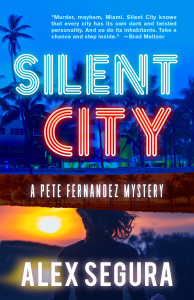 I wasn’t interested in showing off his next case as if it were an episode of an episodic network drama, you know? Where it’s more about the case-of-the-week and less about the characters. I wanted it to feel like an important moment for him and, by the end of the book, show that he’s evolved. When we leave him at the end of Silent City, he’s redeemed himself somewhat, but is also a little unsteady on his feet. From page one of Down the Darkest Street, you know things are getting tougher for him, and it keeps getting worse from there.
I wasn’t interested in showing off his next case as if it were an episode of an episodic network drama, you know? Where it’s more about the case-of-the-week and less about the characters. I wanted it to feel like an important moment for him and, by the end of the book, show that he’s evolved. When we leave him at the end of Silent City, he’s redeemed himself somewhat, but is also a little unsteady on his feet. From page one of Down the Darkest Street, you know things are getting tougher for him, and it keeps getting worse from there.
Once all those pieces appeared in my head, I knew I could make that into a book.
Why is Miami a great crime story setting?
I just feel like there’s so much more to Miami than what people think or assume. It’s not just fun in the sun, palm trees, and beaches. Miami is a big, spread-out town with a lot of unexplored corners and people. I wanted to tell stories about the Miami I knew growing up there—the city, the suburbs, the rich and poor neighborhoods. I love novels with a strong sense of place, like Ellroy’s LA or Lehane’s Boston, where you feel like you’re visiting a new city. So I wanted to do that for Miami, a place that’s no stranger to crime—weird, disturbing, or deadly.
What do you and Pete have in common?
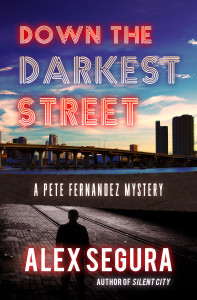
A lot of surface stuff—we’re both from Miami, both Cuban-American, about the same age (I think Pete’s a few years younger!), we both work or worked in newspapers. I liken Pete to someone I knew in high school or college and lost touch with. We have some shared experiences, but are very different people. He’s a lot more impetuous than I am and is probably much more willing to throw a punch or fire a gun. Pete also leads a much more problematic and complicated life than I do. He’s also got a big self-destructive streak I don’t, which I’m grateful for. I wanted to write stories about a protagonist that was familiar to me—in the sense that I could see him clearly and maybe relate to him—but that was also different. I think Pete fits the bill. And as writers, I think we interject ourselves into everything we write, from the leads to the bit players.
__
Silent City is out March 15; Down the Darkest Street is out April 12. Both are available for pre-order right now!
__
Alex Segura is a novelist and comic book writer. He is the author of the Miami crime novel SILENT CITY, the first in a series featuring Pete Fernandez. SILENT CITY and its sequel, DOWN THE DARKEST STREET, are out this year via Polis Books. He has also written a number of comic books, including the best-selling and critically acclaimed ARCHIE MEETS KISS storyline, the “Occupy Riverdale” story and the upcoming ARCHIE MEETS RAMONES. He lives in New York with his wife. He is a Miami native.
The post Three questions with…Alex Segura appeared first on Lori Rader-Day.
January 19, 2016
Little Pretty Things is a Mary Higgins Clark Award nominee!
Well, this is ridiculously exciting.
This morning, Little Pretty Things was named a 2016 Mary Higgins Clark Award nominee!
A full list of nominees for the Edgars and the MHC Award—with many many great friends on it—is here.
I think I’ve said before how much Mary Higgins Clark has meant to me since I was a young reader, and then there was this:
That’s me meeting Mary Higgins Clark in 2012.
Mary Freaking Higgins Clark. Speaking of the queen of suspense… Here’s a piece I had published today by Crimespree magazine about how I went from knowing one mystery writer in all the world to sitting next to Mary Higgins Clark for breakfast—in one year.
Will be celebrating with the other wonderful nominees in New York in late April—can’t wait!
The post Little Pretty Things is a Mary Higgins Clark Award nominee! appeared first on Lori Rader-Day.
December 17, 2015
Interview: Why I’m a Big Fan of Jennifer Kincheloe
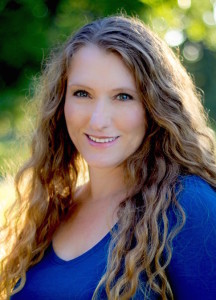 Jennifer Kincheloe and I both write mysteries featuring smart—if somewhat misguided—women protagonists. We interviewed each other about our shared interests, writing, writing some more, and all things writing. Who’s Jennifer Kincheloe? Well, pick up a copy of The Secret Life of Anna Blanc, and you’ll not soon forget her or her character. In its starred review of The Secret Life of Anna Blanc, Booklist called Anna “delightful.” RT Reviews called the book “a keeper,” and I totally agree. If you’re still on the hook for holiday gifts for the reader in your life, look no further. She also says nice things about my books, which is a nice bonus in a friend.
Jennifer Kincheloe and I both write mysteries featuring smart—if somewhat misguided—women protagonists. We interviewed each other about our shared interests, writing, writing some more, and all things writing. Who’s Jennifer Kincheloe? Well, pick up a copy of The Secret Life of Anna Blanc, and you’ll not soon forget her or her character. In its starred review of The Secret Life of Anna Blanc, Booklist called Anna “delightful.” RT Reviews called the book “a keeper,” and I totally agree. If you’re still on the hook for holiday gifts for the reader in your life, look no further. She also says nice things about my books, which is a nice bonus in a friend.
Jennifer Kincheloe: Your latest book Little Pretty Things features a gripping mystery and a motel setting so vivid I can smell it. On top of that, it’s an insightful exploration of the lives of teenage girls—friendship, jealously, competition, exploitation and the fallout from these. When you write a book, what comes to you first, the plot, the settings, or the underlying themes?
Lori Rader-Day: So far, each book has had a different origin story. My first novel sprang from an imagined situation and a location, and then I had to figure out what kind of person would be in this situation. Little Pretty Things came from a character. Juliet Townsend came from my imagining what kind of job I might have had if I had made different but very probable decisions in my life, if I’d gone right instead of left a few times.
Lori: You based the heroine of The Secret Life of Anna Blanc on a real historical figure, a police matron. What was it about that woman and that role that spoke to you?
Jen: LAPD matron Alice Stebbins Wells became the first female cop in LA in 1910. She inspired the book. Alice was a political genius—a kind of evangelist for women in police work internationally. She changed the world of criminal justice forever. However, when I wrote the character of Anna Blanc, Anna ended up being very different from Alice. Anna is more like “I Love Lucy.”
I’m impressed with women who do big, great things. They’ve had to ignore all society’s negative messages about women and trust themselves instead. That takes great clarity and courage. I wish all women could trust themselves and their own strengths and brilliance the way Alice Stebbins Wells did. This is something Anna is learning in the book.
Lori: Anna is at once innocent and brave, silly and smart, feminine and feminist. What process did you go through to create her? How do you balance historical reality and modern expectations for “strong female characters”?
Jen: Anna just came out. There was no strategy involved at all. I was a little worried that she didn’t fit the current mold of “feminist hero” because she’s silly, naive and vain—a product of 1907 sexism and her father’s wealth. But she’s also dauntless and she runs circles around the cops intellectually. I didn’t want her to be too strong or too good. I wanted her to be like an everyday woman who simply believes in herself and never gives up. There are so many examples of strong, brave, flawed women in the Progressive Era. People just don’t remember them because they are left out of the history books. Carrie Nation is a favorite. She was a Temperance crusader. Women weren’t allowed in saloons, but that didn’t stop Carrie from going in with an axe and chopping up the tables.
Jen: Your first novel, The Black Hour, has been met with overwhelming success. When you first wrote the book, before you let it out into the world, did you know that your novel was that good? What has it been like to win or be nominated for virtually every mystery prize in the US on your very first try?
Lori: The first novel benefits from having as much time to be written and revised as you need. When I sent my book out, I loved it. That kind of devotion didn’t come easy, though. I wrote The Black Hour in about a year and a half but then I spent an extra year just on revisions, on reading the book over and over and attacking a honey-do list of things I wanted to make sure I accomplished with draft before I tried to submit it to agents. When I tell aspiring authors I spent a solid year on revisions, they wince. They don’t want to spend extra time. They’re impatient. But so was I, and I spent the time anyway because that was what I needed to feel as though the book was as good as I could make it on my own.
Awards are icing on a pretty great cake. I won’t lie—it’s nice to win. I’m very fond of my Anthony Award bowl. In a fire, I’m grabbing my husband, my dog, and that bowl. But it truly is fun to be nominated for things that other people win, too, because those people are your friends.
Lori: Your debut is already getting great reviews and attention—from men as well as women. Why do you think your book attracts male readers so well, in this era of “women’s fiction”?
Jen: We are told over and over that men won’t read books with female protagonists. I had a movie producer interested in The Secret Life of Anna Blanc say that it could never be a summer blockbuster because those always have male protagonists. There is definitely a stigma associated with historical fiction with a woman on the cover. So I was shocked and delighted to find such an enthusiastic male fan base. (I love you guys!!!). I think there are more and more male feminists out there, and things are starting to change.
Some guys have confessed to having a crush on Anna, maybe because Anna luuuuuuuuvs men. I remember coming to my writer’s group during a heavy snow when it was my turn to be critiqued. Only guys showed up, maybe eight of them, and I was really nervous because they were critiquing a romantic scene for the Anna Blanc sequel. And they loved it. LOVED IT. And believe me, they tell me when they don’t love something.
But maybe the question isn’t why guys like Anna Blanc, but how can we connect more male readers with fabulous female protagonists.
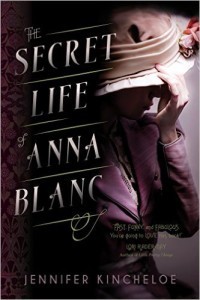 Jen: Now with two great novels under your belt and readers eagerly awaiting your third, do you find writing the next one easier or more difficult?
Jen: Now with two great novels under your belt and readers eagerly awaiting your third, do you find writing the next one easier or more difficult?
Lori: I don’t think the writing of a novel ever gets easy. Writers have too much self-doubt and also pride in their work. If it were easy, we’d get suspicious. Writing a book might get a little less mysterious, though, once you’ve done it once or twice. You know your own process better and trust it, instead of, say, freaking out because you started a murder mystery without knowing why the murder occurred. Once you pull your own story out of the fire once, you suspect you might be able to do it next time, too.
That reader eagerness is the only part that scares me. I want to make sure the next book is as enjoyable as the last, so that pressure is new.
Lori: What do you think your character Anna and my character Juliet have in common? Would they get along?
Jen: Juliet and Anna both start out wrapped up in their own misery, feeling trapped in dead end lives. Over the course of the novels, their eyes are opened to the reality of other women’s experiences and they become more compassionate. They both get empowered and unstuck. There is a sense of new beginnings.
Would my wealthy, self-absorbed protagonist get along with your disillusioned hotel maid? In the beginning of the books, noooooo. I think Juliet would hate Anna. Anna wouldn’t even see Juliet. At the end of the books, after they’ve both grown, absolutely. They’d hold hands and sing kumbaya. Maybe, they’d even solve a crime together.
Lori: If only they lived in the same decade…
The post Interview: Why I’m a Big Fan of Jennifer Kincheloe appeared first on Lori Rader-Day.
December 7, 2015
Three Questions with…Triss Stein
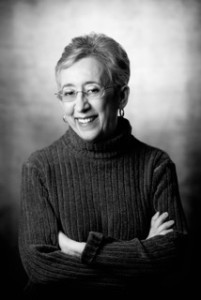 I met Triss Stein at Malice Domestic in early 2015 when we were put on the same panel. It was called “School for Murder,” which suited me just fine because I had a murder mystery set on a college campus. For some of the other panelists, the topic needed to widened up a bit, but we rolled with it and had a good time, as you do at Malice. We had such a good time, in fact, that I had to bring Triss on for three questions for her new book, Brooklyn Secrets, which just came out December 1.
I met Triss Stein at Malice Domestic in early 2015 when we were put on the same panel. It was called “School for Murder,” which suited me just fine because I had a murder mystery set on a college campus. For some of the other panelists, the topic needed to widened up a bit, but we rolled with it and had a good time, as you do at Malice. We had such a good time, in fact, that I had to bring Triss on for three questions for her new book, Brooklyn Secrets, which just came out December 1.
Your Brooklyn series has an obvious locational focus and a feisty protagonist in Erica Donato. Tell us about Erica and what she has in common with Triss?
When I started this series, I wanted a character who was not me but had a more complicated, richer life than the heroine of an earlier short-lived series. She needed to be younger than me, so she would be dealing with the complications of building her life. (Now she’s a lot younger, as it took a long time to get it right. She hasn’t aged a bit but I sure have.) I wanted her to be a native, old time Brooklynite (not me) but with extra perspective (me, a little bit). Her current life, in a gentrifying part of town and a Ph.D. program in urban history, is a long way from the blue-collar neighborhood where she grew up. (Aha! A source of conflict, which all mysteries need!) I added a little—no, a lot!—more conflict by giving her a teen-aged daughter. (Nope, I didn’t have them when I started the book. Mine were all grown up, another way I have perspective she doesn’t.) Her life has not given her much sophistication but it has given her a lot of what used to be called moxie. (Do I have that? Not really.) She is a single mom, whose young husband died in an accident. (I’ve been married a lot of decades.)
And yet. Because I wanted to write about being a mother, she is one. Because I wanted to write about Brooklyn’s varied, fascinating and often mythologized past, she is a historian whose work takes her into some dark stories, both old and new. So though she is not me, in some ways she is me.
There was one more thing I needed. I could make long lists of all the protagonist qualities that would help to tell my stories, but the book didn’t start until I heard her voice. My stories need a narrator. Meet Erica Donato.
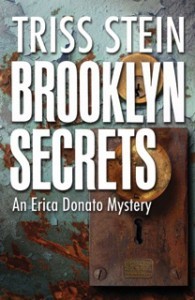 In Brooklyn Secrets, Erica is digging into 1930s research. You must enjoy research to set your character up to do so much of it. How do you approach research as an author?
In Brooklyn Secrets, Erica is digging into 1930s research. You must enjoy research to set your character up to do so much of it. How do you approach research as an author?
I love doing research. I did it as a job in the business world for many years (I am trained as a librarian) but history, not business, is my real love. And it seems that social history, how people actually lived and thought and felt, is what speaks to me. Now I get to pursue my oddball interests to my heart’s content. The tricky part is remembering my job is to tell a story, with the history supporting that…and not the other way around.
Each book has been a little different, but for Brooklyn Secrets and the new work-in-progress I went old school and walked myself into the Brooklyn history room at the Brooklyn Public Library’s central building. (It is a system separate from NYPL). I sat down with a large stack of books, looking them over for the sources that will be most useful for my criminal pursuits. I ask for the clipping files too, and work through the news of the decades, looking for whatever pops out at me. Then I hop on Internet used book sites, such as ABE, and see if I can order up some of the books. Usually they are “used” books, not ”antique” books, and are priced accordingly, often for less than the mailing costs. For Brooklyn Secrets, I ended up with, among others, an academic study of girls growing up in Brownsville, a naive but thorough early history from 1969, and a volume of the photographic series, Images of America, called New York City Gangland. Those mug shots were most inspiring! Now I have them handy to peruse, refer to, write in. Lots of Post-Its will be sacrificed to the cause.
After awhile, themes emerge and important or charming or illuminating details are noted. Of course I do online research too, spot checking facts and—as one does on the ’Net—pursuing threads down unexpected paths well past the point of common sense. It’s a lovely way to procrastinate. For Secrets, I stumbled across an interview with the grandson of a famous Mob leader. He talked about his grandpa’s favorite film depictions of himself! Now that was a very odd disconnect between his mind and what most people call “reality.” And right there, in that gap, is where a story starts. Did I jump on that article? With a thank you to the Writing Goddess? You will find him, transformed by my imagination, in the pages of Secrets.
This is the third Erica Donato book. What advice to you have for mystery writers hoping to start a series themselves?
Think your protagonist through with as much detail as possible. I speak from early efforts that went nowhere, and from two long-ago books that could not carry a series. Does she/he have enough complexity to change over a series? Is her life/work/personal situation complex enough to provide secondary conflicts (conflict = plot) to go along with the main story line? Do you like her enough to spend a lot of time with her? Because you will spend more time with her than you ever expected.
Triss Stein is a small-town girl from New York farm country who has spent most of her adult life in New York the city. This gives her the useful double vision of a stranger and a resident for writing mysteries about Brooklyn neighborhoods in her ever-fascinating, ever-changing, ever-challenging adopted home. In the new book, Brooklyn Secrets, Erica find herself immersed in the old and new stories of tough Brownsville, and the choices its young people make. Learn more at her author site.
The post Three Questions with…Triss Stein appeared first on Lori Rader-Day.
October 13, 2015
Good mood contest
You will not be surprised to find that winning an Anthony Award puts me into a good mood. I want to share it. The mood, not the Anthony. Get your own shiny wooden bowl.
How about a contest? Join my email news list for (seriously) only occasional emails of news and opportunities like, say, contests and I’ll draw out some winners from my entire list. (So if you’re already signed up, you’re golden. You’re in the drawing already for being a loyal reader.)
Sign up for my email list here by midnight on October 16—this Friday—and I’ll draw three winners for some little pretty things. I just decided that they shall be:
First drawing: Poe Ka Dot socks and a signed book of mine (your choice)
Second drawing: Poe Ka Dot zipper pouch a signed book of mine (your choice)
Grand prize drawing: Poe Ka Dot shoulder bag with Starbucks gift card a signed book of mine (your choice)
Fun, right? Winners announced Saturday!
The post Good mood contest appeared first on Lori Rader-Day.

